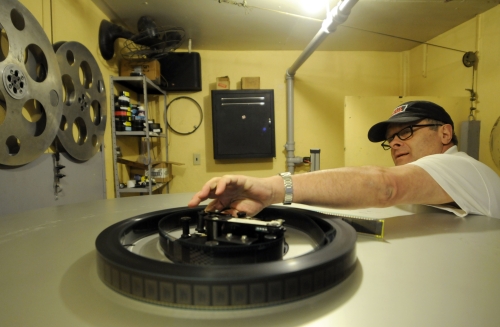BUFFALO, New York (AP) ― The license plate on movie projectionist Arnie Herdendorf’s Buick is 35MM MAN, a nod to his work in the booth at the 1925 Palace Theatre, with its velvet-draped stage and chandeliered mezzanine.
When he drove recently to a multiplex to watch as its film projectors were swapped out for new digital ones, the sight of old 35 mm workhorses “stacked up like wounded soldiers’’ had him wondering how long his title ― or job ― would be around.
The questions are even bigger for historic movie houses themselves.
With the future of motion pictures headed quickly toward an all-digital format played only on pricey new equipment, will the theaters be around? Or will they be done in by the digital revolution that will soon render inadequate the projectors that have flickered and ticked with a little-changed technology for more than 120 years?

Arnie Herdendorf feeds film into the platters in the projection room at the Palace Theater, in Lockport, New York on Sunday. (AP-Yonhap News)
“Our guess is by the end of 2013 there won’t be any film distributed anymore,’’ said John Fithian, president and chief executive of the National Association of Theater Owners.
The Hollywood studios’ industry-wide conversion from 35 mm film to digital satisfies modern-day demands for crisp clarity, cost savings and special effects like 3-D. And for big-budget theaters where new releases occupy multiple screens, installing digital projectors is a no-brainer. Already, about 60 percent have converted in the United States, at a price of $70,000 to $80,000 a screen, Fithian said.
But for the community-owned Palace and other small and historic movie houses, the merging of nostalgia with high-tech is a dauntingly expensive proposition. Yet one, most agree, that is critical if they are to keep attracting audiences to their light bulb-studded marquees. The cost is more than double the price of a top-of-the-line film projector.
“The Riviera Theatre is listed on the historic register, but we are not a museum,’’ Executive Director Frank Cannata said from the 1927 theater north of Buffalo, “so it’s important that we stay current ... and staying current isn’t always affordable, as we’re all finding out.’’
An estimated 500 to 750 historic theaters currently show movies, according to the Theatre Historical Society of America, though it adds no one has formally researched the number and the estimate is conservative.
“This is another major threat to these theaters which were largely rescued and restored by grass-roots local efforts,’’ said Karen Colizzi Noonan, president of the THS, which records and preserves theaters’ architectural and cultural history. “It is so sad that after all that hard work and dedication these groups now face another huge challenge just to survive.’’
And survival means doing whatever they can to raise the cash to convert.
Supporters of the privately owned Davis Theatre in Higginsville, Missouri, are vying for a $50,000 prize in a Reader’s Digest contest that would help pay for digital equipment for the 500-seat main auditorium. They were in second place at the start of February, with a month of voting to go.






![[KH Explains] Hyundai's full hybrid edge to pay off amid slow transition to pure EVs](http://res.heraldm.com/phpwas/restmb_idxmake.php?idx=645&simg=/content/image/2024/04/18/20240418050645_0.jpg&u=20240419100350)